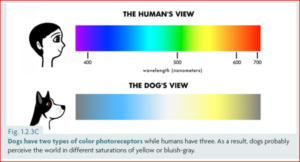9 Dog & Cat Myths: Debunked!

Dogs have cleaner mouths than humans. Cats always land on their feet. These and many other myths about pets have been circulating for many years, and some have real staying power. You may have heard some of these before, or perhaps they are all new to you. We’re here to separate fact from fiction when it comes to myths about our pets!
Myth #1: Dogs see in black & white.

Truth: Dogs can perceive color, but not every color, and as a result, they do not see color as vibrantly as we do.
Dogs can only see shades of blue, yellow, and green and their vision is blurrier in brighter light. They make up for their sight disadvantages with their incredibly strong sense of smell, though.
Myth #2: A dog’s mouth is cleaner than a human’s mouth.
Truth: Not quite.
Dogs’ mouths contain almost as many bacteria as humans. It’s difficult to determine which is “cleaner” because the bacteria found in a dog’s mouth are different than the bacteria in a human’s mouth. Luckily, though, most of the bacteria found in dogs’ mouths can’t transmit disease to humans due to being species-specific.
Myth #3: A wagging tail means a happy dog, and a purring cat is a happy cat.
Truth: Purring generally means a cat is happy, but it can also mean they’re stressed, sick, or in pain. Some believe that it is a self-comforting mechanism that help cats rest and repair.
Similarly, a wagging tail on a dog generally means they’re happy, but can also indicate that they’re nervous. Researchers found that a dog’s tail wagging to the right indicates positive emotions (content or excited) while wagging to the left indicates negative emotions (stressed or anxious).
Myth #4: It’s okay to skip flea and tick preventative during the winter.
Truth: Fleas can live outdoors in temperatures as low as ~33 degrees, and ticks become active in temperatures above ~40 degrees. Since our Northeast winters often fluctuate in temperature, veterinarians recommend that dogs stay on flea and tick (and heartworm) medication year-round. This really is a case where “an ounce of prevention is worth a pound of cure.”
Myth #5: Dogs eat grass only if they are sick.
Truth: Eating grass doesn’t always mean your dog is sick (though sometimes it does). Dogs eat grass for many possible reasons such as to improve digestion, to fulfill a nutritional need, or just because they’re bored or they like the feel and taste of it.
Myth #6: Cats always land on their feet.
Truth: Although felines possess the “air-righting reflex” which allows them to correct their bodies as they fall so they can land on their feet, don’t always count on them doing it unscathed. If the height of the fall is too low, they will often land on their side. If the height of the fall is too high, they may land on their feet but suffer serious internal or bone injuries.
Myth #7: Female dogs should have one litter of puppies before they get spayed.
Truth: There is no evidence to support that having a litter of puppies before getting spayed reaps any long-term health benefits for female dogs. In reality, spaying a dog before her first heat cycle actually decreases many health risks such as developing mammary tumors or uterine infections.
Myth #8: There are hypoallergenic dog breeds.
Truth: There is no such thing as a hypoallergenic dog. Most people think that allergies come from a dog’s fur, but it actually comes from a protein in a dog’s saliva and urine that sticks to dogs’ skin and sheds with their fur. Dogs who have hair (instead of fur – Poodles for example), or dogs who don’t shed are better choices for people with allergies. In these breeds, the allergy-causing protein isn’t released as often due to the dog not shedding as much. So, “hypoallergenic dogs” shed fewer allergens into your home and the air, but they aren’t actually hypoallergenic.
Myth #9: Dogs feel guilt.
Truth: Dogs can feel primary emotions such as happiness, sadness, and fear, but there is no evidence to support the fact that they feel secondary emotions like shame or guilt. When dogs appear guilty, it has been thought that it is a learned response to a human reaction. They respond to what their owners are doing, but do not know that they did something wrong and therefore can’t feel bad for it. Interestingly, it is believed that smiling is also a learned human response in dogs.
Sources & More Information:
- https://www.petmd.com/dog/general-health/what-colors-do-dogs-see
- https://www.akc.org/expert-advice/health/is-dogs-mouth-cleaner-than-humans/
- https://www.livescience.com/45196-why-do-dogs-wag-their-tails.html
- https://www.catster.com/cat-behavior/why-do-cats-purr
- https://www.petmd.com/dog/seasonal/evr_multi_flea_tick_mosquito_care_during_winter
- https://pets.webmd.com/dogs/why-do-dogs-eat-grass#1
- https://www.thenakedscientists.com/articles/interviews/myth-do-cats-always-land-their-feet
- https://www.petmd.com/dog/care/setting-record-straight-spay-and-neuter-myths
- https://www.mayoclinic.org/diseases-conditions/pet-allergy/expert-answers/hypoallergenic-dog-breeds/faq-20058425
- https://www.hillspet.com/dog-care/behavior-appearance/do-dogs-feel-guilt-or-shame
- https://www.huffingtonpost.com/entry/dog-body-language-what-does-it-mean_us_55e0ba1ce4b0c818f617dd42
Written by RACHAEL GILLIS